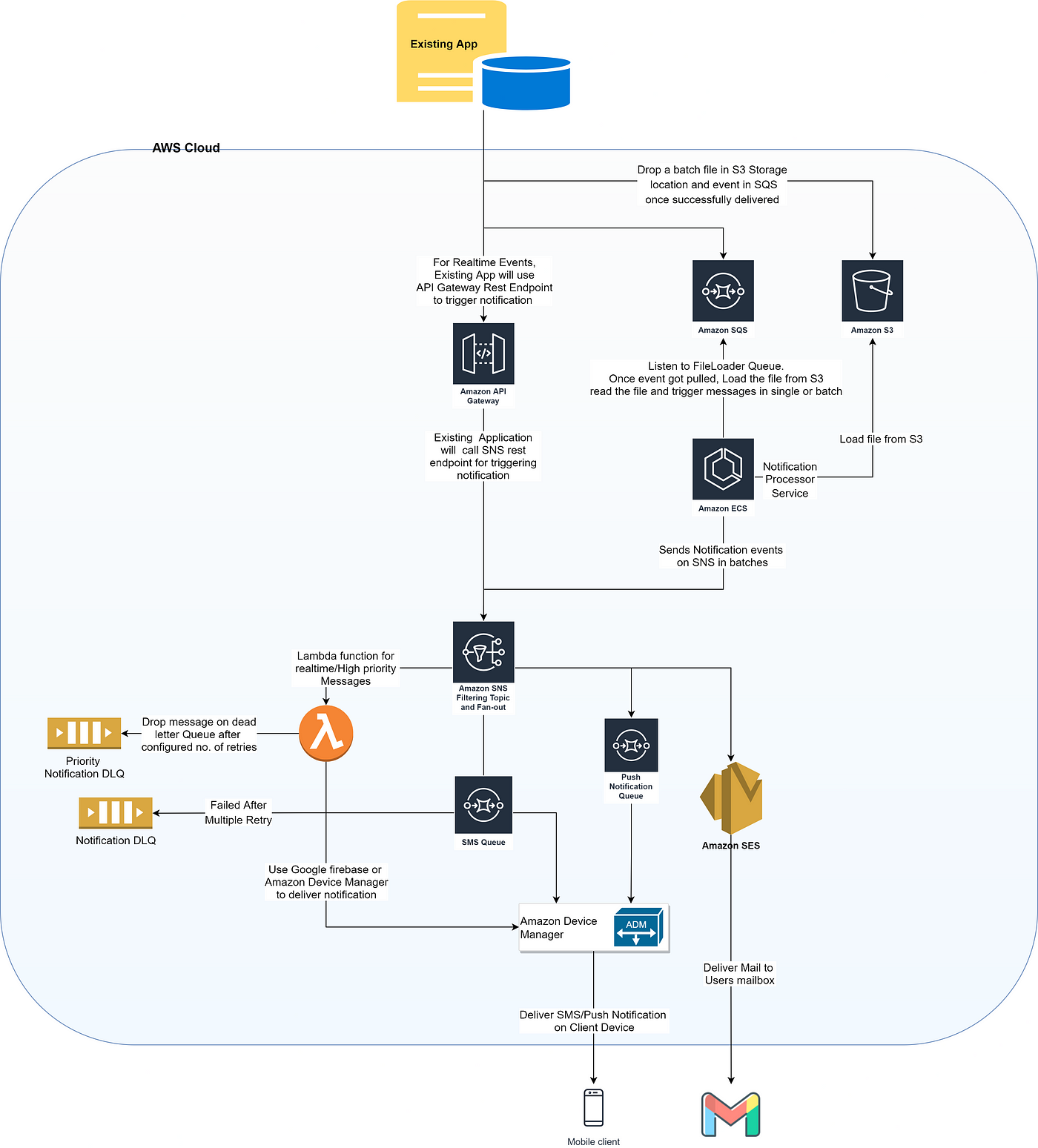Centralised Notification System with AWS Native Services
 Ravinder Singh
Ravinder SinghIn today's interconnected digital landscape, businesses often operate multiple products and services, each generating notifications for users. Without a unified approach, this can lead to inconsistent user experiences and increased operational complexity. Implementing a Centralized Notification System addresses these challenges by providing a cohesive framework for managing and delivering notifications across all platforms. In this blog, we'll explore the key considerations for building such a system and delve into the critical design decisions that ensure its effectiveness.
Scope of the Centralized Notification System
A robust centralized notification system should encompass the following objectives:
Scalability: The system must handle a vast volume of notifications, ranging from millions to potentially billions daily, without performance degradation.
Reliability: Given that notifications can be transactional and time-sensitive, the system should guarantee delivery with zero data loss.
Versatility: Support for both real-time and batch processing is essential, accommodating immediate notifications and scheduled bulk messages.
Multi-Channel Delivery: The system should seamlessly integrate various notification channels, including email, SMS, push notifications, and in-app alerts.Appian Community
User Preferences: Allowing users to customize their notification preferences enhances user experience and engagement.
Monitoring and Analytics: Comprehensive tracking and reporting mechanisms are vital for assessing system performance and user interaction with notifications.
Design Decisions for an Effective Notification System
Designing an effective centralized notification system involves several critical decisions:
Microservices Architecture: Adopting a microservices approach ensures that each notification channel operates as an independent service. This modularity facilitates scalability, maintenance, and the ability to deploy updates without affecting the entire system.
Message Queuing: Implementing a message queuing system, such as Apache Kafka or AWS SQS, enables reliable message delivery and decouples message production from consumption. This setup ensures that notifications are queued and processed asynchronously, enhancing system resilience.
Database Selection: Choosing the appropriate database is crucial. Relational databases like PostgreSQL are suitable for storing structured data, such as user preferences and notification logs. NoSQL databases like MongoDB can handle unstructured data and support high write throughput, essential for real-time notifications.
Load Balancing: Incorporating load balancers distributes incoming traffic evenly across servers, preventing any single server from becoming a bottleneck. This ensures high availability and optimal resource utilization.
Notification Templates: Utilizing templating engines allows for dynamic content generation in notifications. This ensures consistency and personalization, enhancing user engagement.
User Preferences Management: Developing a user-friendly interface for managing notification preferences empowers users to control the types and frequency of notifications they receive, reducing the likelihood of notification fatigue.
Monitoring and Logging: Implementing robust monitoring tools and logging mechanisms is essential for real-time system health checks and troubleshooting. Tools like Prometheus for monitoring and ELK Stack for logging provide valuable insights into system performance.
Security Measures: Ensuring data security and user privacy is paramount. Implementing encryption protocols for data in transit and at rest, along with strict access controls, protects sensitive information and maintains user trust.
By carefully considering these design aspects, organizations can develop a centralized notification system that is scalable, reliable, and user-centric, ultimately enhancing communication effectiveness across all products and services.
Designing Scalable Notification Systems with AWS native services

Architecture Overview
A scalable notification system should support multiple channels (email, SMS, push, in-app alerts) and handle high traffic efficiently. The following AWS services play a vital role:
1. Amazon SQS (Simple Queue Service) – Message Queueing
Acts as a buffer between application components, ensuring message durability and asynchronous processing.
Helps decouple microservices, allowing notifications to be processed independently without performance bottlenecks.
2. Amazon SNS (Simple Notification Service) – Event Distribution
Used for fan-out messaging, sending notifications to multiple subscribers (email, SMS, mobile push, or other services).
Supports direct publishing from application servers or through AWS Lambda triggers.
3. AWS Lambda – Serverless Processing
Triggers on new messages from SQS, SNS, DynamoDB Streams, or event sources.
Executes business logic (e.g., formatting messages, logging, handling retries) without managing servers.
4. Amazon SES (Simple Email Service) – Email Notifications
Provides a scalable way to send transactional emails (OTP, account alerts, reports).
Can be integrated with SNS for email bounces and complaints monitoring.
5. Amazon S3 – Storage for Bulk notification files, Logs and Reports
Create a bulk file for all notifications to be sent in batches like campaign notifications, etc.
Stores notification logs, email reports, and analytics data.
Can trigger Lambda functions for data processing or archiving.
6. Amazon DynamoDB – Storing Notification Preferences
Stores user preferences (e.g., email vs. SMS, frequency, opt-outs).
Ensures low-latency access for personalized notifications.
7. Amazon CloudWatch – Monitoring and Logging
Tracks message delivery success/failure rates.
Sends alerts on failures, helping maintain system reliability.
Subscribe to my newsletter
Read articles from Ravinder Singh directly inside your inbox. Subscribe to the newsletter, and don't miss out.
Written by

Ravinder Singh
Ravinder Singh
Senior Architect with 15 years of experience in development, Design, Analysis, and Implementation of large-scale distributed systems using Java, micro services, open source, messaging, streaming and cloud technologies. Experience in Core technology and deployment strategy, System Design, Architecture and Technology Consulting for various transformation, migration or Greenfield projects.